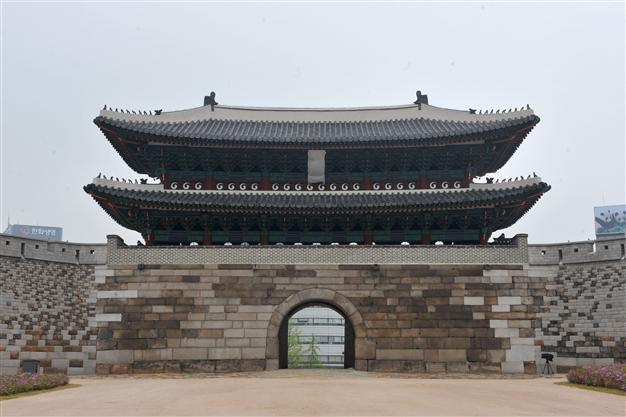South Korea unveils restored cultural treasure
SEOUL - Agance France-Presse

The newly-restored Namdaemun gate, a treasured 14th century historical landmark burned to the ground in an arson attack in 2008, stands in Seoul on April 29, 2013. AFP Photo
Five years after it was reduced to ashes in an arson attack, the newly rebuilt Namdaemun gate in South Korea was unveiled Monday after a painstaking reconstruction costing millions of dollars.The cultural jewel in central Seoul will reopen to the public on Saturday, following one of the longest and most expensive restoration projects ever undertaken in South Korea, involving hundreds of highly skilled craftsmen.
"Using traditional methods and materials, we've done our best to restore it to its original state," said Kang Kyung-Hwan, head of the government's Heritage Conservation Bureau.
Seoul's 600-year-old Namdaemun (South Gate) is listed as "National Treasure Number One" and is a source of immense cultural pride.
The largely wooden structure -- which survived the devastation of the 1950-53 Korean War -- was reduced to ashes by a disgruntled 69-year-old man with some paint thinner and a cigarette lighter on February 10, 2008.
He torched the gate after claiming he had received insufficient compensation following the expropriation of his land as part of an apartment-building project in Seoul's northwestern satellite city of Koyang.
The five-year, 27-billion-won ($24.4 million) reconstruction project involved 35,000 people, including more than 1,000 craftsmen who used traditional tools to restore the gate to its former splendour.
"The restoration took longer than we originally thought because my team used no modern tools, only chisels and hammers," Lee Eui-Sang, a 72-year-old master stone carver, told AFP on Monday during a tour for the press.
"At first I was so nervous about restoring our precious national treasure, but I've poured all my energy into rehabilitating our crucial cultural heritage," he said, stroking a new base stone.
The restoration team said the original stones and materials were used as far as possible, while a number of scorched wooden pillars were left in their damaged state to alert the public to the danger of fire.
Fortress walls that were destroyed during Japan's 1910-45 colonial rule were returned to their original form and were reconnected to the gate.
All 22,000 roof tiles were made by hand. Decorative paints had to be imported from Japan, since Korean specialists had lost the art of making them in the traditional fashion.
"It's wonderful to see our foremost national treasure again. The gate looks unfamiliar due to its fresh paint but I think our pride has been restored," said Lee Un-Seok, a 35-year-old engineer passing by the landmark.
The pagoda-style, two-storey gate was first constructed in 1398, then rebuilt in 1447 and renovated several times after that.
It was one of four gates built to protect the city when it was the capital of the Joseon Dynasty, which ruled the Korean peninsula from 1392 until the Japanese occupation in 1910.
Its destruction in 2008 sent shock waves through the country, with sorrowful citizens swarming around the charred ruins, laying flowers and writing grieving messages.
The arsonist was eventually sentenced to 10 years in prison.
"He should have been jailed forever for destroying National Treasure Number One. It was restored wonderfully but my chest still feels tight," said 65-year-old Kim Song-Hyun who stopped to look at the gate, pointing to some stones stained by smoke.
"This gate is not in the same shape despite enormous efforts by craftsmen. From now on we must preserve Namdaemun and other national treasures well," said 38-year-old office worker Kim Hyo-Sung.
The government vowed to make preventing another fire a top priority.
Infrared cameras sensitive enough to detect the flame of a cigarette lighter have been installed, along with additional surveillance cameras and 152 sprinklers.
"The gate is now protected by a perfect fire prevention system," said Kang of the Heritage Conservation Bureau.
But his office admitted that Namdaemun would not be totally free from the threat of damage despite the high-tech devices and called for public safety awareness.
















